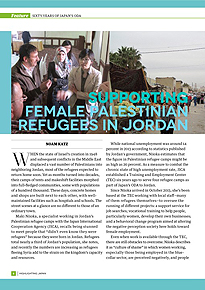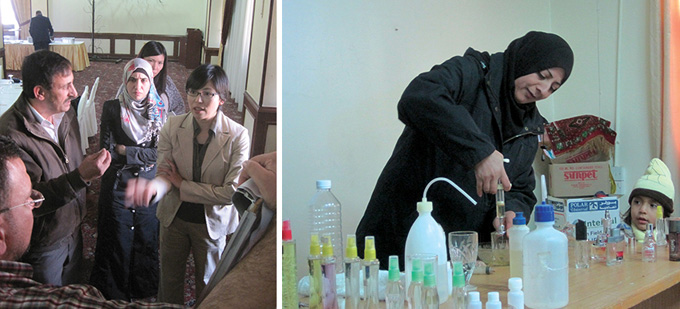Home > Highlighting JAPAN >Highlighting Japan August 2014>Sixty Years of Japan's ODA
Highlighting JAPAN

Sixty Years of Japan's ODA
Supporting Female Palestinian Refugees in Jordan

When the state of Israel’s creation in 1948 and subsequent conflicts in the Middle East displaced a vast number of Palestinians into neighboring Jordan, most of the refugees expected to return home soon. Yet as months turned into decades, their camps of tents and makeshift facilities morphed into full-fledged communities, some with populations of a hundred thousand. These days, concrete homes and shops are built next to each other, with well-maintained facilities such as hospitals and schools. The street scenes at a glance are no different to those of an ordinary town.
Maki Niioka, a specialist working in Jordan’s Palestinian refugee camps with the Japan International Cooperation Agency (JICA), recalls being stunned to meet people that “didn’t even know they were refugees” because they were born in Jordan. Refugees total nearly a third of Jordan’s population, she notes, and recently the numbers are increasing as refugees fleeing Syria add to the strain on the kingdom’s capacity and resources.
While national unemployment was around 14 percent in 2013 according to statistics published by Jordan's government, Niioka estimates that the figure in Palestinian refugee camps might be as high as 20 percent. As a measure to combat the chronic state of high unemployment rate, JICA established a Training and Employment Center (TEC) six years ago to serve four refugee camps as part of Japan’s ODA to Jordan.
Since Niioka arrived in October 2013, she’s been based at the TEC working with local staff—many of them refugees themselves—to oversee the running of different projects: a support service for job searches; vocational training to help people, particularly women, develop their own businesses; and a behavioral change program aimed at altering the negative perception society here holds toward female employment.
Even when work is available through the TEC, there are still obstacles to overcome. Niioka describes it as “culture of shame” in which women working, especially those being employed in the blue-collar sector, are perceived negatively, and people are very sensitive to how others think of them. If a woman works outside the home, for example, others may think her husband’s income is insufficient; women may turn down hard-earned factory jobs, either because they care how others perceive them and prefer the higher status of office work, or due to objections from a male member in the family such as her husband or father.
Given the social importance for married women to remain at home, the vocational training program teaches them how to produce and sell their own soaps, creams and perfumes made using local methods while working at home. “Women have told me that thanks to this, they are able to pay the rent or school fees,” Niioka explains. “They also change from being passive consumers to active producers, and they start to have more confidence because they can now contribute to household income.”
While changing attitudes and lifestyles is far from simple, the behavioral change program, which is a long-term initiative that includes hands-on workshops and campaigns, can broaden thinking on social and religious norms. “Many people here think that Islam prohibits women from working,” Niioka notes. To counter that perception, she and her staff launched a campaign with posters as well as behavioral change workshops in which they teach ways women in the workforce can abide by Islam, such as by working in locations separate from men.
Niioka has witnessed firsthand how employment empowers women and changes lives in positive ways. For example, one woman with facial birth defects found a job through TEC because she wanted to change her own life, but was initially rejected by the employer because of her appearance. TEC staff appealed to the factory on her behalf, and she got the job. She used the money she earned to have reconstructive surgery on her face, which in turn helped her relationships with coworkers. “She became much more outgoing,” adds Niioka.
Aware of the impact working women have on others, Niioka hopes to have some of them speak to other women about how employment has transformed their lives. “I think that would be a turning point for society,” she says.
© 2009 Cabinet Office, Government of Japan






